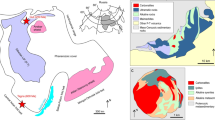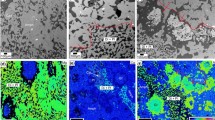Abstract
IN recent years the attention of petrologists has been directed towards understanding the behaviour of basaltic magma in the light of experimental data. While observational and experimental results have progressively enriched our ideas on the reaction principles in sub-alkaline basic magma, “the possible and necessary reactions” in alkali basaltic magma series have been overlooked1. The broad petrographic differences between tholeiitic and alkali basaltic series obviously reflect the possible deviations in the reaction processes in the two magma types. The nature and cause of such deviations in reaction relations will be discussed elsewhere. The normal course of fractionation of alkali basaltic magma leads to the development of an undersaturated alkalic liquid where the undersaturation is inherited from the parent magma. Such late liquids are normally more alkaline than similar products from tholeiitic magma as the mafic phases in alkali basaltic magma invite greater amounts of calcium at the expense of plagioclases, causing a relative enrichment of soda in the residue. Accordingly the derivative of the alkali basaltic magma descends down to the lower quadrilateral in Petrogeny's Residua system2, though the exact degree of undersaturation will largely depend on the bulk composition of the initial parent magma and the compositions of the separated mafic phases. Even if the liquid comes down just below the feldspar join in the said system, fractionation of alkali feldspar leads to a decrease of silica: alkalis ratio in the liquid and thus its undersaturation is augmented.
This is a preview of subscription content, access via your institution
Access options
Subscribe to this journal
Receive 51 print issues and online access
$199.00 per year
only $3.90 per issue
Buy this article
- Purchase on Springer Link
- Instant access to full article PDF
Prices may be subject to local taxes which are calculated during checkout
Similar content being viewed by others
References
Yoder, H. S., and Tilley, C. E., J. Petrology, 3, 342 (1962).
Bowen, N. L., Amer. J. Sci., 33, 1 (1937).
Miyashiro, A., and Miyashiro, T., J. Fac. Sci. Tokyo. Univ., 10, 1 (1956).
Streckeizen, A., Intern. Geol. Cong. Rept. Pt. 13, 228 (1960).
Bewen, N. L., J. Geology, 23, 55 (1915).
Tuttle, O. F. (personal communication).
Saha, A. K., Ph.D. thesis, University of Toronto (1958).
Ringwood, A. E., Beit. Min. Petrolog., 6, 346 (1959).
Schuiling, R. D., Nature, 201, 1115 (1964).
Bose, M. K., Min. Mag., 33, 912 (1964).
Bose, M. K., Amer. Min., 48, 1405 (1963).
Author information
Authors and Affiliations
Rights and permissions
About this article
Cite this article
BOSE, M. Differentiation of Alkali Basaltic Magma. Nature 207, 1187–1188 (1965). https://doi.org/10.1038/2071187a0
Published:
Issue Date:
DOI: https://doi.org/10.1038/2071187a0
This article is cited by
-
Analysis of deformation fabric in an Alkaline Complex (Koraput): Implications for time relationship between emplacement, fabric development and regional tectonics
Journal of the Geological Society of India (2009)
Comments
By submitting a comment you agree to abide by our Terms and Community Guidelines. If you find something abusive or that does not comply with our terms or guidelines please flag it as inappropriate.



